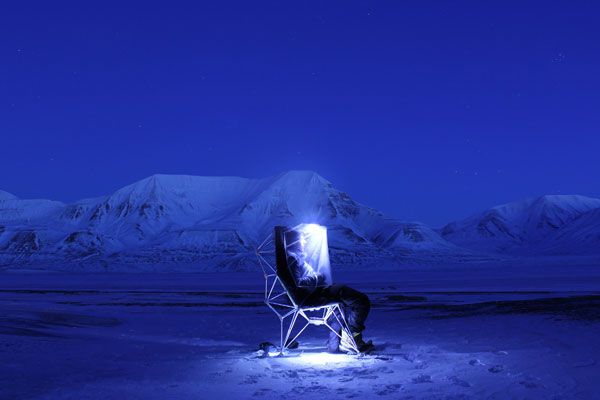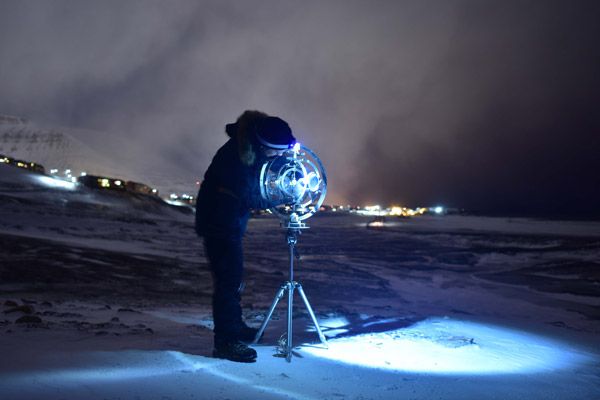Design and architecture in the Arctic is explored in a new exhibition now on at the Hong Kong Design Institute. Christie Lee writes.

December 30th, 2015
Top image: Differential Enclosure. Photo by David Garcia
Frigidly cold, expansive and replete with heavy white snow, the Arctic has always been a mystery for many.
Organised by the Hong Kong Design Institute, Hong Kong Institute of Vocational Education (Lee Wai Lee) and the Royal Danish Academy of Fine Arts, School of Architecture, The Arctic group exhibition in Hong Kong brings us a step closer to understanding this largely untamed region.
Comprising prototypes, videos, infographics and images, the exhibition came out of a three-week expedition to the Arctic in 2014, which was led by David Garcia, a professor at the Royal Danish Academy.
During the expedition, 28 students from the Architecture and Extreme Environments programme were each asked to conceive of a project that explored the design and architectural potential of a pristine yet wildly erratic environment.
“[The exhibition] describes a teaching methodology and creates awareness towards the practice of design and architecture, its strengths and flaws. It also presents a territory that is distant and extreme, but important to everyone,” explains Garcia.

Indeed, The Arctic goes beyond the realm of pure problem solving for one that balances function with aesthetics.
A highlight is Anita Eriksen’s “Steam and Light – Study of Water’s Architectural Potential”. Inspired by the beauty of geothermal power, the installation comprises seven stacked cubes. When both light and geothermal steam are introduced, the latter diffuses the former, giving more substantial form to the otherwise invisible steam.
A second exhibit explores ways of preserving human body warmth – by converting it into electricity that can be used for other purposes – and yet a third features an artificially-moulded ice shell that is used as temporary shelter against extreme conditions.
In exploring the potential and dangers of building in untamed locales, The Arctic also asks the question – should architects take up the responsibility of ensuring that the pristine, unspoiled environment of the wild be kept?
Garcia notes that “research can and should be as low impact as possible, but the minute we decide to inhabit and settle, the impact is unavoidable. Towns and cities have a large impact in their immediate environment and beyond. The question is, how can that impact be a considered one, where the resulting legacy of a settlement can be as balanced as possible?”
The Arctic runs through 22 February 22 2016 at C002 – Experience Center, Hong Kong Design Institute and Hong Kong Institute of Vocational Education (Lee Wai Lee).
A searchable and comprehensive guide for specifying leading products and their suppliers
Keep up to date with the latest and greatest from our industry BFF's!

XTRA celebrates the distinctive and unexpected work of Magis in their Singapore showroom.

Elevate your outdoor spaces with pieces that are beautiful, functional, and engineered for you.

The Man x Machine x Material collaboration by Jarrod Lim and The American Hardwood Export Council explores how generative AI can enhance design processes while also revealing the areas where human intuition remains irreplaceable.

In this candid interview, the culinary mastermind behind Singapore’s Nouri and Appetite talks about food as an act of human connection that transcends borders and accolades, the crucial role of technology in preserving its unifying power, and finding a kindred spirit in Gaggenau’s reverence for tradition and relentless pursuit of innovation.

What is A+D’s role in our emotional wellbeing? To create buildings that lift and inspire us on a daily basis through colour, light and form.
Esther Stewart’s exhibition pieces are functional furniture fittings that change the space surrounding them.
The internet never sleeps! Here's the stuff you might have missed

The beauty of design often lies in its visual brilliance – the mesmerising forms, colours, and textures that ignite our collective imagination. But beneath the surface resides the quiet engineer of design integrity that ultimately determines its relevance and enduring impact: authenticity.

This chair makes flexible working easier than ever, thanks to intelligent engineering and human centred design.